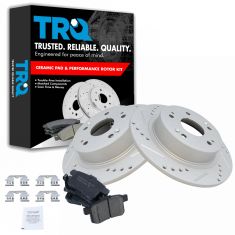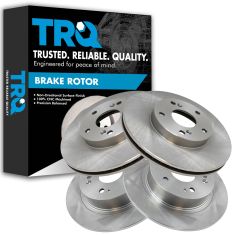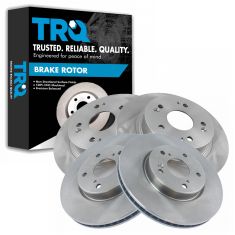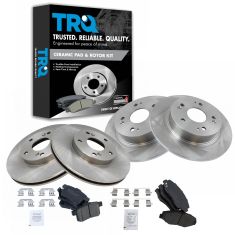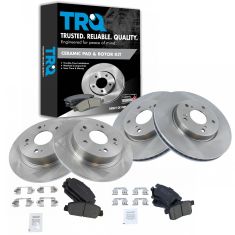1ABFS01246-Honda Accord Acura TSX Rear Ceramic Brake Pad & Rotor Kit TRQ BKA11083
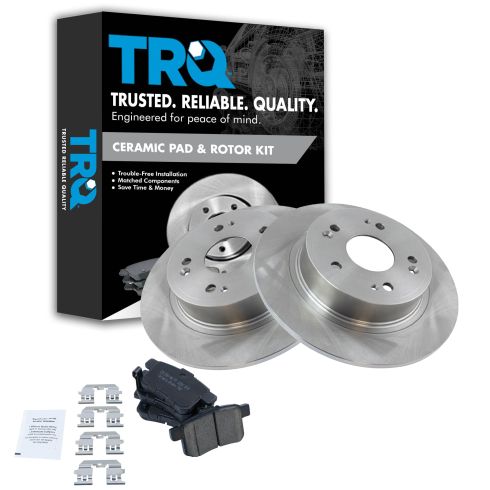
Replaces
2016 Honda Accord Rear Ceramic Brake Pad & Rotor Kit TRQ BKA11083

Product Reviews
Loading reviews
4.95/ 5.0
19
19 reviews
Perfect fit and working great
July 20, 2017
Pads and rotors are a perfect fit for my 2008 Coupe. Easy install and the brakes work great now. Great value!
Brake Parts Purchase
May 26, 2018
Easy to order and received parts quickly. I am well satisfied.
1A is A1
October 24, 2018
What got me was the price. I couldn’t believe I could get the entire brake job done for that little. The price for the rotors, pads, and hardware was just a little more than one rotor at the local parts store! I ordered it, being a little skeptical about the quality but boy was I surprised. Everything fit great ! Thanks 1A, you’re A1! Gene E.
A1Service
November 14, 2018
This was a great deal for me very affordable and great parts for my vehicle
Very glad to made purchase from 1 aAuto.
December 25, 2018
I recommend buying my auto parts purchase from 1aauto, my overall experience to buy online was never easier then this, from looking for products, prices, shipping options every thing was so easy and quick , and its tax free purchase. Would buy my next auto needs surely from this site.
Easy instal!
March 18, 2019
Pads fit nicely. No brake noise.
Awesome parts!
March 22, 2019
I ordered these and received them super fast!!! They were a little noisy at first but they just needed to break in, no problems ever since!
Great Price
November 25, 2019
I didn't think i could find an affordable Break Kit. Thanks to my co-worker I learn about this site. No complaints on the performance so far.
Brake kit
July 1, 2020
Works great! Thanks for the quick shipping and service. Will definitely purchase again.
First time buyer
March 5, 2021
I purchased the rotors and pads because they were the best price I could find. I was happy with the fit and quality of the product. The installation was as simple as using oem parts. I found my new supplier for my automotive needs. They work great!
2012 accord rear breaks and rotors
March 26, 2021
everything fit as it should. Even came with grease and all the hardware. save me lots of time and energy not having to run around. Easy to accomplish in an hour
great brakes
March 25, 2022
Fit great and are quiet.
June 4, 2022
I like the part and got fast delivery
Awesome
July 17, 2022
This kit works great for 2012 Honda Accord lx.
happy
November 21, 2022
parts fit perfect
Parts are perfect
[{"url": "https://wac.edgecastcdn.net/001A39/prod/media/pNISJll75W64CYGsite/db28af0f50940bf4d01e57bbf05fed34_1669844508522_0.jpeg", "caption": "She was neglected."}, {"url": "https://wac.edgecastcdn.net/001A39/prod/media/pNISJll75W64CYGsite/d295688522c3a21351174d4a8089e4ea_1669844578624_0.jpeg", "caption": "Sigh of relief! They are perfect fit."}]
November 30, 2022
First time doing brake pads, rotors and calipers. Im of the age where physically things are more challenging but with great customer service, accurate delivery times and the video library, I was capable of getting the job done. Needed help braking caliper mounting bolts and tightening the bolts to torque specs. I was able to get the job done! Parts where perfect fit and performance is excellent. All I can say is take your time and any doubts refer to You Tube for the video appropriate application. Thank you to everyone.
April 22, 2023
Good fit right.
September 5, 2023
Perfect fit and easy to install.looking to purchase the front kit soon!
May 30, 2024
Perfect fit, great quality
Customer Q&A
Will this fit in 2017 honda accord sport se?
September 29, 2021
10
Yes, this part will fit your vehicle.
September 29, 2021
T I
will this fit my 2013 honda accord sport?
December 26, 2021
10
Yes, this part will fit your vehicle.
December 27, 2021
Ricale A
Will these fit the ex model?
February 18, 2022
10
Yes, this part will fit your vehicle, as long as your year, make, and model match up with our listing.
February 18, 2022
Kelly S
Will this fit in 2010 Honda Accord exl?
August 27, 2022
10
Yes, this part will fit your vehicle.
August 27, 2022
Cristina P
Will these rear brake and rotors fit a 3.5L V6 Honda Accord?
February 8, 2023
10
This kit is listed to fit all 2008-2017 Honda Accord models. Engine size will not affect the fitment.
February 8, 2023
Jessica D
will this fit a 2012 honda accord se?
April 7, 2023
10
Yes, this will fit your vehicle.
April 7, 2023
Andra M
Will thise rotors fit Honda Accord 1997?
July 18, 2024
10
Currently, we do not carry this part for your vehicle. We're always updating our inventory so please check back soon!
July 19, 2024
Nick R
Honda is a registered trademark of Honda Motor Co., Ltd. 1A Auto is not affiliated with or sponsored by Honda or Honda Motor Co., Ltd.
See all trademarks.









